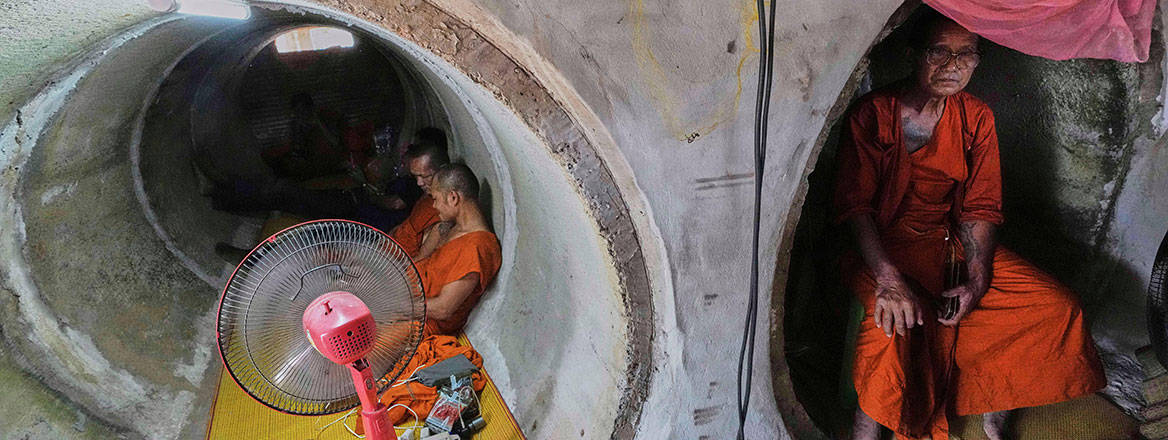Old Borders, New Battles: Thailand, Cambodia and an Unfinished War
Rooted in centuries of history, the border conflict between the two countries is set to flare up again unless underlying causes are addressed.
The recent ceasefire and ongoing talks between Thailand and Cambodia are fragile bandages over a long-festering wound. It was brokered by Malaysia – and closely observed by China and the US, along with other Southeast Asian countries – after weeks of escalating military clashes, a politically explosive phone call, and open hostilities that threatened to turn a simmering border dispute into a regional conflagration. The current calm is welcome, but may prove temporary. Without reckoning with deeper historical, domestic political and geopolitical dynamics driving this conflict, it is only a question of when, not if, we will see another round of confrontation.
A Deep Historical Divide
The roots of today’s dispute go back to the days of the Khmer Empire, which dominated much of mainland Southeast Asia from the 9th to 13th centuries, including large parts of present-day Thailand. As the Khmer Empire declined, the rise of Siam (precursor to modern Thailand) brought a reversal of fortunes. Over the ensuing centuries, much of the territory now contested, including key temples and other sites sacred to many on both sides, fell under Siamese control.
This back-and-forth dynamic continued until France, having established itself as the colonial power in Cambodia in the late 19th century, sought to formalise borders in Indochina. The 1907 Franco-Siamese Treaty redrew the map, jeopardising Thai control over several religious and culturally significant sites, including the famous Preah Vihear Temple. Thailand (then still Siam) signed the treaty, but resentment and controversy lingered.
The temple and surrounding areas became the symbolic and strategic epicentre of territorial contention. During the Second World War, when France was under Nazi occupation and Japan had gained control over most of Southeast Asia, Thailand seized the opportunity to occupy much of the disputed borderland. After the war, Thailand was evicted from these areas, but the trauma of that reversal lived on in nationalist memory.
Courts, Conflict and Cambodia’s Civil Wars
The post-war dispute moved from the battlefield to the courtroom; specifically, the International Court of Justice (ICJ). In 1962, the ICJ ruled in favour of Cambodia, reaffirming its sovereignty over the Preah Vihear Temple and nearby areas. Thailand accepted the ruling grudgingly, but public dissatisfaction remained high, especially among nationalist factions in Thai politics.
The Preah Vihear Temple and surrounding areas became the symbolic and strategic epicentre of territorial contention
Later in the 1960s and throughout the 1970s, Cambodia plunged into intense internal strife marked by civil war, American invasion, genocide under the Khmer Rouge, and, eventually, Vietnamese invasion and occupation. During this time, armed groups frequently crossed into Thailand, often seeking refuge, other times less benignly. The border became an alarmingly lawless zone of guerrilla activity, human trafficking and smuggling. While Thailand remained relatively stable and closely aligned with the US and the UK, its proximity to the chaos in Cambodia and elsewhere made it a frontline regional player in the Cold War.
The installation of a pro-Hanoi regime following Vietnam’s 1979 invasion of Cambodia marked a turning point. Although the Vietnamese victory effectively removed the Khmer Rouge from power, it also created disequilibrium. Thailand, aligned with Western powers and deeply suspicious of Vietnam, became a base for anti-Vietnamese resistance groups and hosted many Cambodian refugees (including some linked to the Khmer Rouge).
Only after the Vietnamese withdrawal following the Paris Peace Agreements of 1991 and the eventual establishment of a transitional government in Phnom Penh in 1993, with Hun Sen rising to the premiership, did relative calm return on the border. In the late 1990s, Thaksin Shinawatra rose to power in Thailand, becoming prime minister of a populist government in 2001 that found common cause with Hun Sen’s authoritarian pragmatism. For nearly a decade, the two leaders’ close personal relationship helped normalise relations and de-escalate tensions.
A Fragile Peace Unravels
When Thaksin was ousted by a military coup in 2006, Thailand’s domestic politics entered a period of prolonged instability, characterised by mass protests, judicial interventions, repeated coups and other leadership changes. To a large extent, this period continues to this day.
In 2008, tensions over the Preah Vihear Temple flared again, after Cambodia successfully had it classified as a UNESCO World Heritage Site. Thai nationalists accused the Cambodian government of using the UN to further parochial territorial claims. From 2008 to 2011, a series of violent skirmishes erupted, killing dozens of soldiers on both sides and displacing thousands of civilians. Once again, the ICJ was asked to intervene, issuing a clarification in 2013 that reaffirmed Cambodian sovereignty over the temple and adjacent areas.
Still, the underlying issues were never fully resolved. The border remained poorly demarcated, nationalist narratives in both countries went unchallenged, and military forces on both sides maintained a heavy presence and alert stance. The absence of durable bilateral or multilateral dispute resolution mechanisms meant that the situation remained volatile, awaiting only the right spark to reignite.
The 2025 Crisis: Escalation and Exposure
That spark came in May 2025, when an otherwise routine incident between Cambodian and Thai patrols in the disputed area escalated into a gunfight. Normally, such incidents can be managed through backchannel communication or field-level disengagement protocols. But this time, an unexpected political twist turned a minor clash into a national – and regional – crisis.
Shortly after the incident, Prime Minister Paetongtarn Shinawatra, daughter of former Prime Minister Thaksin, phoned Hun Sen to try to smooth over tensions. Hun Sen, in turn, leaked recorded audio of the call to the media. This leak caused an uproar in Thailand, leading to Paetongtarn Shinawatra’s suspension as prime minister and creating something of a political free-for-all in Bangkok.
While the political scandal was still unfolding, a Thai soldier lost his leg to a landmine, which Thai authorities then claimed had been laid recently by Cambodian forces. This further inflamed nationalist sentiments. Over the following days, Thailand launched a series of airstrikes and artillery barrages on Cambodian border posts and nearby settlements. Cambodian retaliation was limited, in part because of its weaker military capabilities and in part perhaps because Hun Sen and his successors if office sought to avoid escalation (as certainly also did China).
China, America and the Regional Chessboard
Behind the scenes, another player watched closely: China. Cambodia has long been one of Beijing’s most important and steadfast regional partners. In recent years, Chinese investment has transformed parts of Cambodia’s economy, while Chinese military support helped modernise its armed forces. A Chinese naval base under construction along Cambodia’s southern coast has raised alarms in Washington and Bangkok (and Hanoi) alike.
Thailand’s relationship with China is more complex. While the two countries share strong trade ties and growing military cooperation, Thailand also maintains a security alliance with the US and has been cautious not to fall too closely into Beijing’s orbit. The current border conflict puts Thailand in an awkward position – caught between asserting its territorial claims, advancing its economic and diplomatic agendas, and managing its strategic balancing act.
The absence of durable bilateral or multilateral dispute resolution mechanisms meant that the situation remained volatile, awaiting only the right spark to reignite
China, for its part, has been keen to appear as the honest broker – a regional player on good terms with both combatant parties ready to serve as mediator and guarantor of any peace. Weakening Thailand’s ties to Washington and the West would also further China’s broad strategic interests in Southeast Asia.
The US, meanwhile, has not played much of a public role, but is present at ongoing talks in Kuala Lumpur. If the Trump administration is paying attention, American interests would be to preserve and enhance its security relations with Thailand while preventing China from leveraging strong economic links to force a settlement.
Other countries in ASEAN (Association of Southeast Asian Nations), notably Malaysia (now in the chair), have sought to place themselves at the centre to show that Southeast Asia can resolve its own problems without undue American or Chinese intervention. It seems likely that some kind of deal can be struck, for now. What is less clear is whether any peace will last beyond the next scandal or crisis and what the implications will be for the overall balance of power and influence in mainland Southeast Asia.
Where Do We Go From Here?
Neither Thailand nor Cambodia has much incentive for meaningful concessions or compromise. Cambodia is clearly in a much weaker position in military and state capacity terms. China has strong ongoing interests in protecting Cambodian sovereignty and therefore in checking Thailand. The US should continue to press for peace and stability, especially inside Thailand, with which it has an important security partnership. Most other Western powers, including the UK, will have, if anything, even stronger incentives to ensure Thailand’s regional position is maintained or enhanced. Others in Southeast Asia, notably Malaysia right now, but especially the Philippines, Vietnam and Indonesia looking ahead, will have divided opinions on whether it is better to back Cambodia or Thailand or to remain neutral. But they share a commitment to ASEAN and to strengthening regional dispute resolution mechanisms and to mediating this and other conflicts without too much direct involvement by outside powers like the US or China. The Thai–Cambodian conflict is thus likely headed for suspended animation, awaiting the next crisis, rather than any long-term stable resolution or equilibrium.
© RUSI, 2025.
The views expressed in this Commentary are the author's, and do not represent those of RUSI or any other institution.
For terms of use, see Website Terms and Conditions of Use.
Have an idea for a Commentary you'd like to write for us? Send a short pitch to commentaries@rusi.org and we'll get back to you if it fits into our research interests. View full guidelines for contributors.
WRITTEN BY
Professor William Hurst
RUSI Senior Associate Fellow, International Security
- Jim McLeanMedia Relations Manager+44 (0)7917 373 069JimMc@rusi.org



